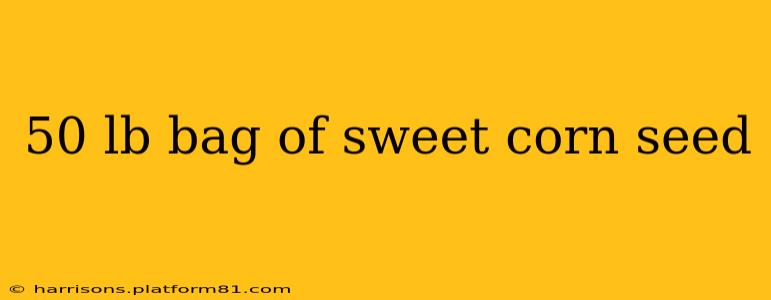Buying a 50lb bag of sweet corn seed represents a significant investment, whether you're a large-scale farmer or an enthusiastic home gardener with ambitious planting plans. This guide dives deep into everything you need to know before making such a purchase, covering aspects from seed selection to storage and beyond. We'll answer many frequently asked questions to ensure you're fully informed and prepared for a successful harvest.
What are the different types of sweet corn seeds available in a 50lb bag?
Sweet corn varieties are numerous and choosing the right one depends on factors like your climate, planting season, intended use (fresh eating, freezing, canning), and personal preferences. You'll encounter various types within a 50lb bag offering, categorized by things like maturity, kernel type (sugary, supersweet, etc.), and plant height. Some common types include:
- Sugary Enhanced (SE): Offers a balance of sweetness and texture, suitable for various purposes.
- Supersweet (SH2): Known for its exceptionally high sugar content and tender kernels, ideal for fresh consumption.
- Sweet Corn Hybrids: These combine desirable traits from different parent plants, offering disease resistance, improved yield, and uniform maturity.
How many plants will a 50 lb bag of sweet corn seed yield?
The number of plants you can grow from a 50lb bag varies greatly depending on the seed type and planting density. Seed counts per pound also differ based on seed size. You'll need to check the seed packet or supplier information for the seeds per pound (SPP) and germination rate. For example, if your seed has a SPP of 5,000, then a 50lb bag would contain 250,000 seeds. However, remember to factor in the germination rate (often around 85-95%), which means not all seeds will sprout. Proper planting spacing is crucial to ensure optimal growth and yield. Consult recommended spacing guidelines provided by your seed supplier for the specific variety you've selected.
How much does a 50 lb bag of sweet corn seed cost?
The price of a 50lb bag of sweet corn seed fluctuates depending on the variety, supplier, and current market conditions. Factors such as hybrid vs. open-pollinated, organic certification, and demand all play a role in the final cost. It's best to contact seed suppliers directly to obtain the most up-to-date pricing information. Always compare prices from several reputable suppliers before making your decision.
How to store a 50 lb bag of sweet corn seed properly?
Proper storage is critical to maintaining seed viability. Sweet corn seeds should be stored in a cool, dry, and dark place. Avoid temperature fluctuations and high humidity. Ideally, store the bag in a sealed container to protect it from moisture and pests. Always check the seed packet for specific storage recommendations provided by the supplier. Maintaining optimal storage conditions can significantly impact the germination rate and overall success of your planting.
What are the best practices for planting sweet corn seeds from a 50 lb bag?
Successful sweet corn cultivation requires careful planning and execution. Here are some key considerations:
- Soil preparation: Ensure well-drained, fertile soil enriched with organic matter. A soil test can help determine necessary nutrient amendments.
- Planting depth and spacing: Follow the recommendations provided with your specific seed variety.
- Planting time: Sweet corn thrives in warm soil temperatures (at least 60°F). Consult your local frost dates to determine the optimal planting time.
- Watering and fertilization: Consistent moisture is key, especially during germination and early growth stages. Regular fertilization according to soil test results ensures healthy plant growth.
- Pest and disease management: Monitor for potential pests and diseases and implement appropriate control measures as needed.
What is the shelf life of sweet corn seeds?
The shelf life of sweet corn seeds varies depending on storage conditions. Generally, most high-quality seeds retain good viability for 2-3 years, but optimal storage can extend this period. Always check the seed packet for the manufacturer's suggested shelf life and heed those guidelines. Older seeds may have lower germination rates, so testing germination before planting a large quantity is a wise precaution.
By carefully considering these factors and following best practices, you can maximize your yield and enjoy a bountiful harvest from your 50lb bag of sweet corn seed. Remember that proper planning, research, and attention to detail are essential for successful corn cultivation, regardless of the scale.
